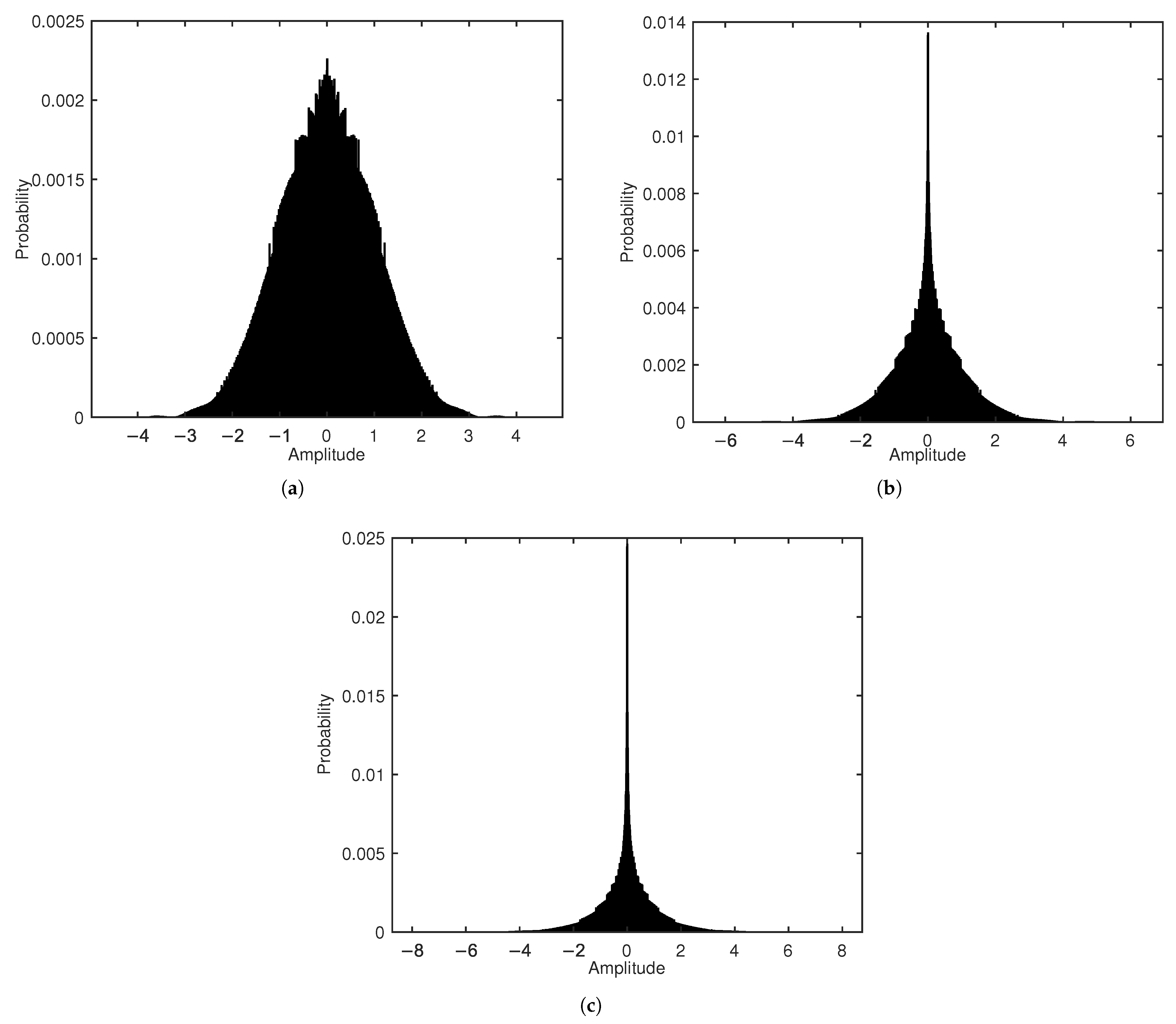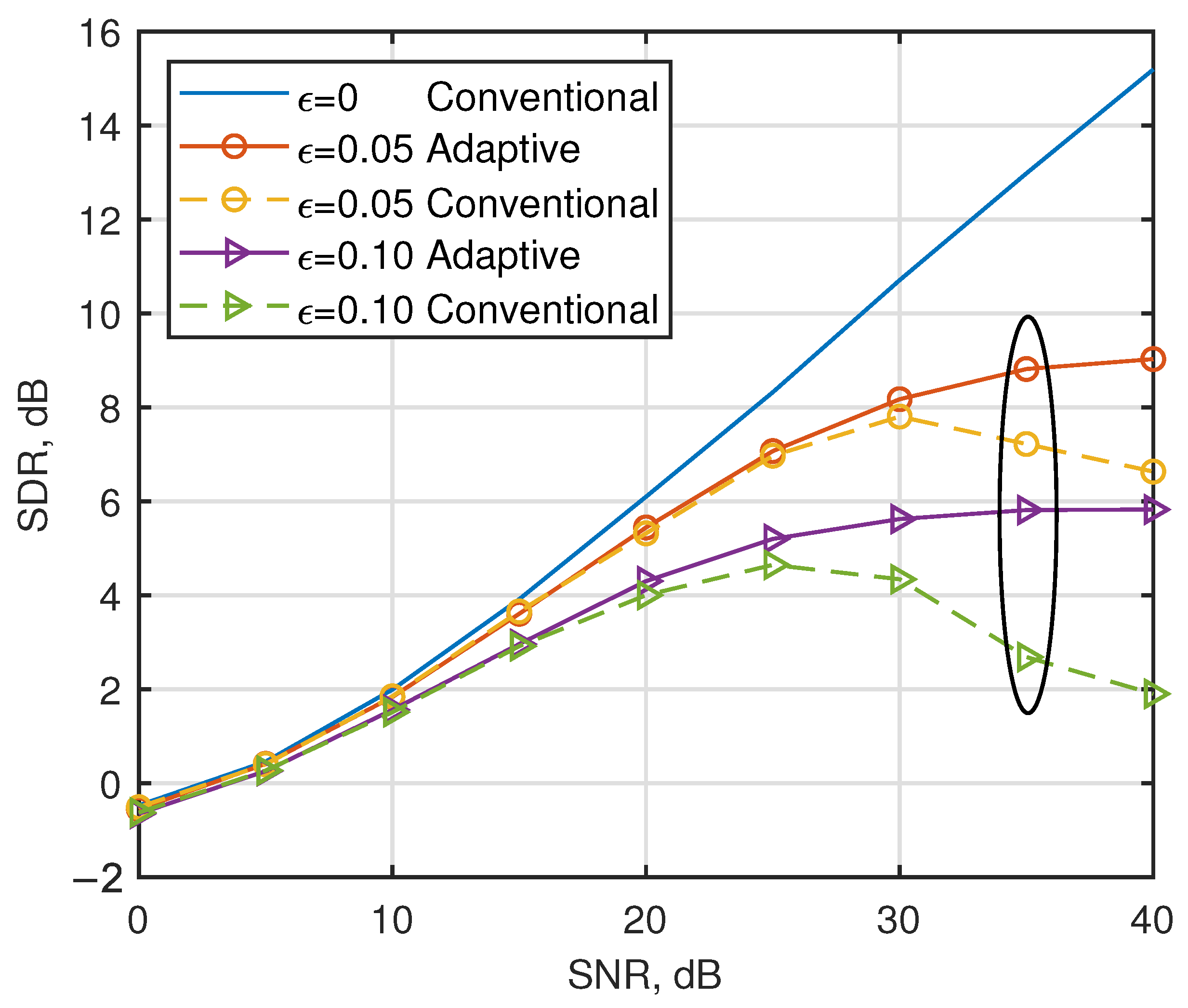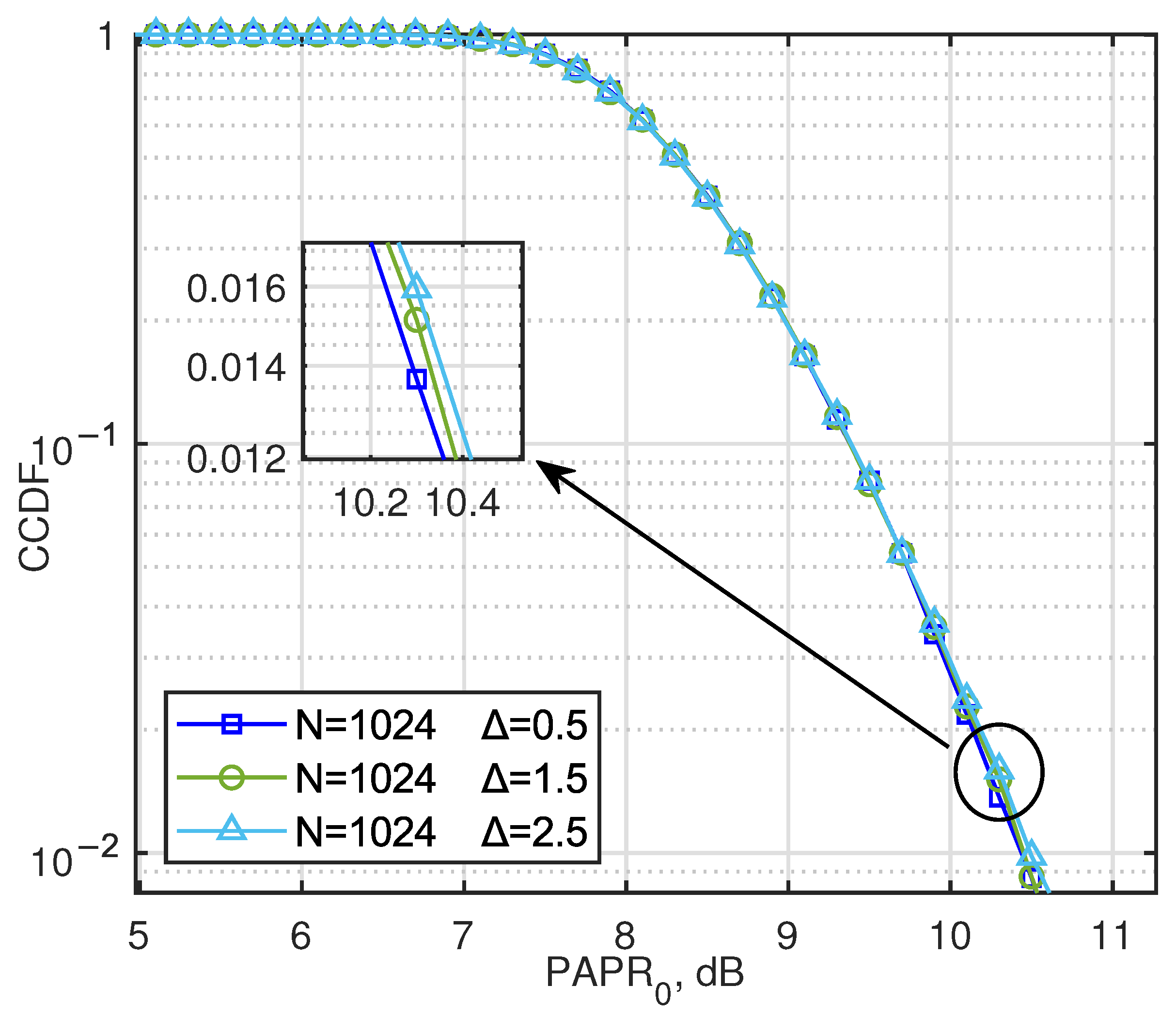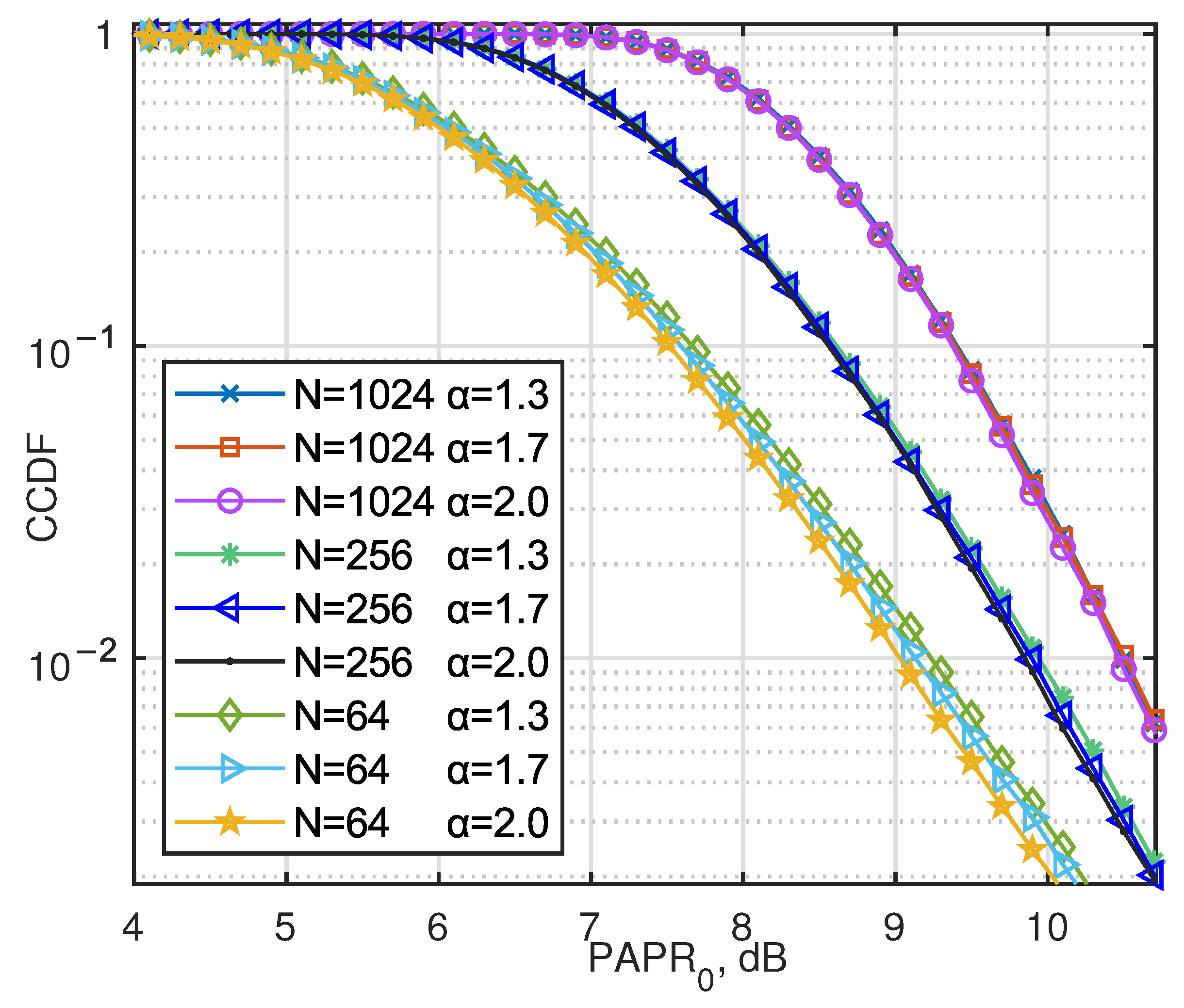1. Introduction
The separated coding system [
1] initially eliminates redundant information via source coding techniques (e.g., quantization, entropy coding) and subsequently employs channel coding methods (e.g., low-density parity-check codes [
2]) to introduce redundancy for enhancing interference resistance. While this system can theoretically achieve the Shannon limit under ideal assumptions [
3], practical applications reveal several limitations; for example, the cascading error propagation caused by channel errors leads to the collapse of source decoding, the fixed redundant design in a low-noise environment results in low resource efficiency, and the infinite code length can not conform to actual communication. These limitations affect the adaptability of time-varying channels. On the other hand, traditional digital joint source-channel coding (JSCC) systems [
4,
5] aim to minimize end-to-end distortion by designing joint codebooks through the simultaneous optimization of source compression and channel protection at the coding level, which can approximate the Shannon limit. However, this approach encounters challenges such as explosive complexity, insufficient flexibility, and implementation difficulties. Consequently, these systems struggle to effectively handle real-time fading channel environments.
Shannon and Goblick [
6,
7] have proposed mapping information symbols onto parametric curves within the continuous signal space to approximate optimal performance limits using the geometric structure of high-dimensional signal spaces. Recent studies [
8,
9] indicate that the analog joint source channel coding (AJSCC) strategy achieves near-optimal performance through simple nonlinear symbol mapping. Specifically, this method directly maps source samples with continuous amplitudes to channel symbols to bypass the digitization process, including quantization, entropy coding, and error correction coding, while utilizing nonlinear curves or surfaces such as spiral curves for dimensionality transformation. The Shannon–Kotel’nikov (S-K) mapping-based AJSCC strategy combines continuous geometric structures with parameter adaptation, achieving performance close to the theoretical limit while maintaining low complexity [
9]. The S-K mapping can realize direct source-to-channel mapping through spatial parameter curves and adopt finite parameters to shape the distribution of sending symbols, which is efficient and flexible enough to adapt to different communication scenarios. This strategy is particularly well suited for low-latency requirements in time-varying communication environments such as Internet of Things devices and real-time media transmission domains. Its core innovation lies in replacing discrete codebooks with nonlinear curves and achieving “progressive optimization” through analog processing, thereby providing an efficient and near-optimal solution for low-latency communications.
Recent advancements have been made in the implementation of maximum likelihood (ML) [
8] and minimum mean square error (MMSE) [
10] receiving algorithms for S-K mapping at the receiver end. In wireless communication scenarios, research has demonstrated that S-K mapping significantly enhances system performance in diversity reception technologies [
11]. Multiple access technology [
12] can increase the throughput of AJSCC systems. Combined with code-division multiple access (CDMA) [
13], S-K mapping can realize multi-user analog joint transmission with low complexity and low delay in multi-access channels. Similarly, S-K mapping exhibits robust performance in multiple-input multiple-output (MIMO) systems [
14]. The proposed mapping can achieve high spectral efficiency and low complexity in MIMO orthogonal frequency division multiplexing (OFDM) systems via MMSE precoding and adaptive parameter optimization, and the resulting performance approaches the theoretical limit [
15].
In practical scenarios using OFDM, such as optical communications [
16], low-earth orbit satellite communications [
17], aeronautical communications, and high-speed rail communications [
18], unstable hardware components or high-speed terminal movement can often cause mismatches in the local oscillators between the transmitter and receiver, resulting in significant carrier frequency offset (CFO). This offset induces inter-carrier interference (ICI), posing serious challenges to multi-carrier communication system performance and necessitating in-depth research with effective solutions.
This paper investigates a joint optimization and performance analysis of the AJSCC-OFDM systems in the presence of CFO. Furthermore, considering that AJSCC parameter changes may affect the symbol distribution of the transmission channel, we examine the peak-to-average power ratio (PAPR) at the transmitter. Finally, we present the variations in PAPR for the AJSCC-OFDM systems.
The remainder of this paper is organized as follows:
Section 2 reviews the fundamental knowledge of AJSCC-OFDM systems;
Section 3 analyzes the impact of CFO on the AJSCC-OFDM systems; in
Section 4, we discusses the joint optimization in the presence of CFO; the PAPR is analyzed in
Section 5;
Section 6 presents our simulation results and experimental findings; finally,
Section 7 provides concluding remarks.
3. Analysis of AJSCC-OFDM with Carrier Frequency Offset
In communication systems, high-speed motion of the transmitter and receiver (e.g., satellites, aircraft, high-speed trains) leads to signal frequency compression or stretching. Additionally, insufficient precision or temperature-induced drift in local oscillators at both the transmitter and receiver result in mismatches between carrier frequencies. Even a tiny frequency offset can disrupt the orthogonality of subcarriers [
19] and induce ICI. In this section, the impact of CFO is taken into account in the optimization.
Assuming that the normalized CFO is
, phase rotation is introduced into the received time domain signal due to frequency offset; thus, Equation (8) becomes
where
is the diagonal matrix of
and the diagonal elements are
. Time-domain analysis indicates that CFO will introduce phase rotation. To fully understand its influence, the frequency-domain distortion caused by CFO is analyzed below.
The receiver performs DFT on
to obtain a signal in the frequency domain:
where
is the frequency domain interference matrix caused by the CFO.
The element
of matrix
represents the interference coefficient of the
q-th subcarrier to the
p-th subcarrier, namely,
which is basically the ICI matrix in OFDM systems impaired by CFO. As shown in [
20], assuming that the receiver has ideal channel state information (CSI) and can fully compensate the total phase offset, the effective channel
can be transformed into
, which produces a time-varying rotation of the AJSCC-OFDM data.
Then, by considering the effective channel as expressed by
and performing the classical zero-forcing equalization, from Equation (16) we obtain
where
, which results in an increase in equivalent noise power and changes the noise distribution characteristics.
4. Joint Optimization
As established in the preceding section, increasing the AJSCC parameter enhances the system’s noise immunity, while adaptive adjustment of the parameter enables dynamic symbol distribution shaping to accommodate complex channel conditions. Therefore, we advocate re-optimizing the systems.
This section develops a joint
optimization strategy to maximize the SDR of AJSCC-OFDM transmissions subject to CFO constraints. The joint optimization strategy is summarized in Algorithm 1. During the simulation process, for each SNR condition, the AJSCC encoder adapts to different CFO factors
in the fading channel by traversing its own parameters, as shown in the algorithm on line 6.
| Algorithm 1 Joint Optimization Scheme |
- Input:
- 1:
Initialize , - 2:
for to do - 3:
for to do - 4:
- 5:
- 6:
- 7:
- 8:
- 9:
- 10:
end for - 11:
end for - 12:
find the maximum SDR and record corresponding parameters: - Output:
|
In AJSCC systems, the parameter
represents the double spiral arm spacing of the mapping curve, which directly determines the distribution characteristics of the coding symbol in the signal space. The value of the
parameter is positively correlated with the mapping distortion [
21] and negatively correlated with system performance. With a larger
, the mapping curve is more sparse and the mapping error is larger; as a result, the system performance decreases. Specifically: (1) Relationship between the value of
and the spatial distribution: When the value of
is small, the mapping curve shows a dense distribution in the sign space, which can cover the source space more precisely and improve the encoding resolution, whereas when the value of
is large, the mapping curve distribution is relatively scattered and a large interval is maintained between each coding symbol.
(2) Trade-off between and system robustness: In scenarios with poor channel conditions (high noise), adopting a larger value can enhance the robustness of the systems to noise and reduce system distortion by increasing the symbol spacing; when the channel conditions are excellent (low noise), a smaller value can be selected to reduce the mapping error through a dense spiral distribution.
(3) Practical application considerations: According to the real-time channel conditions, the systems adjust the key parameters
and
to cope with different degrees of carrier offset. This can be seen from the fluctuation of the data
in
Table 1. When a significant CFO (equivalent noise power increase) is detected, the systems automatically increase the
value and enhance the noise tolerance by extending the symbol spacing. In harsh channel conditions (high CFO), a large
value combined with an optimized
parameter is used to ensure communication reliability. In this case, the systems gradually reduce
and adjust
to enhance system robustness as channel conditions improve.
5. Peak-to-Average Power Ratio
Given that joint optimization of
will change the amplitude distribution of emission symbol, in this section we present simulations carried out to investigate the PAPR characteristics of the proposed AJSCC-OFDM systems. Ignoring the CP, the instantaneous PAPR [
22] is defined by
The PAPR is evaluated by complementary cumulative distribution function (CCDF), which is defined as the probability of the
of a signal exceeding a threshold
, i.e.,
Assuming that the AJSCC symbols are zero-mean and i.i.d. random variables with independent in-phase and quadrature components, the real and imaginary parts of the
l-th element of an AJSCC-OFDM block are provided by
The real part is not correlated with the imaginary part when
. Because
is a Laplacian distribution with zero mean, it is obvious that
; thus, it is only necessary to prove
The expectation of expanding the product is
where
. Using the statistical properties of
, we have the following:
- (1)
Independence: Both and are independent (); therefore, we have cross-terms .
- (2)
Zero mean: .
- (3)
No correlation between real and imaginary parts: For further details, please refer to the symbol distribution presented in
Figure 2, which adheres to the aforementioned three statistical characteristics. Let us say
; thus, we only need to consider the terms
:
If
(power balance), then the above formula simplifies to
Thus, the real and imaginary parts of the time-domain symbol
satisfy Equation (
24).
After establishing that
consists of i.i.d. random variables with zero mean, we can invoke Lyapunov’s central limit theorem to demonstrate that as
N approaches infinity, the AJSCC-OFDM symbols can be approximated by i.i.d. normal random variables. Consequently, the CCDF of PAPR of AJSCC-OFDM changes from Equation (
25) to the following formula:
which is identical to that of OFDM. Obviously, when the length of DFT increases, the value of CCDF for the same threshold
will increase significantly.
6. Simulation
In this section, we focus on evaluating AJSCC-OFDM systems over multipath fading channels. Our analysis not only validates the preliminary findings but also extends the analysis through CFO and PAPR to verify the robustness of the AJSCC strategy in complex environments. A multipath channel model with strong interference, namely, a three-path channel with equal power gain, is considered to test the robustness of this strategy. Specifically, we consider a three-path channel , i.e., , where obeys the normalized Rayleigh distribution and .
6.1. Signal-to-Distortion Ratio Performance
In this subsection, the CFO is systematically analyzed for the frequency-sensitive characteristics of multi-carrier systems.
Figure 3 shows the SDR for AJSCC-OFDM in the presence of CFO over multipath fading channels. Interestingly, the figure shows that the conventional parameters employed by [
15] for multipath channels demonstrate limited robustness against phase offset induced by CFO, leading to performance degradation on the part of the systems. The proposed adaptive parameter optimization strategy effectively mitigates the SDR degradation observed in high-SNR regimes, achieving a 3.1 dB improvement compared to conventional parameter configurations when SNR = 35 dB with
. Let us now turn our attention to the solid line. It can be seen that under the condition of low SNR (SNR < 15 dB), the noise power is dominant and the MMSE equalizer can effectively suppress the noise interference. However, in the case of high SNR (SNR = 35 dB), the influence of noise is negligible and the ICI caused by CFO becomes the main factor limiting system performance. The phase rotation caused by CFO not only leads to energy leakage between subcarriers due to ICI, but also disrupts the continuity of S-K mapping, preventing the accurate recovery of the analog signal during decoding at the receiving end. Specifically, when the normalized CFO factor
increases from 0.05 to 0.10, the SDR of the AJSCC-OFDM systems decreases significantly by 3.0 dB.
Figure 4 shows the SDR of the considered strategies for different
. In high-SNR regimes, CFO-induced ICI becomes the dominant degradation factor. However, excessive CFO renders signal decoding infeasible irrespective of SNR levels.
Figure 5 shows the SDR of AJSCC-OFDM in the presence of CFO for different AJSCC parameters
. The results demonstrate that
= 1.7 exhibits greater robustness against ICI-induced degradation compared to
= 2.0, which is consistently observed across both low and high SNR regimes. Moreover, the performance gap becomes larger with increasing frequency offset; when the offset factor
rises from 0.05 to 0.10, the SDR difference expands from approximately 0.3 dB to 0.5 dB.
6.2. Peak-to-Average Power Ratio Performance
Considering the unique symbolic characteristics of AJSCC and the multi-carrier superposition effect in this subsection, the PAPR characteristics of the system transmitter are analyzed in detail.
Figure 6 provides the CCDF of the PAPR in AJSCC-OFDM systems. It can be seen that in analog communication, PAPR inevitably increases as the number of subcarriers
N increases after the transmission waveform of multi-carrier systems is superimposed, as proved in the last part. The probability of PAPR exceeding 10.6 dB is less than
regardless of whether the number of subcarriers
N is 64 or 1024.
Further, the parameter optimization of AJSCC systems is considered, that is, the optimal delta is searched under each SNR. We provide the PAPR situation of the sender for different
cases, as shown in
Figure 7. The results show that different
values have little effect on PAPR, which is mainly due to the normalization function of the AJSCC encoder.
Figure 8 shows a significant correlation between the PAPR characteristics and the symbol distribution parameter
, especially when the number of subcarriers
. As shown in
Figure 2, when
, the amplitude distribution of the symbols exhibits a high kurtosis characteristic with the energy concentrated near zero, resulting in a lower PAPR value; conversely, when
, the PAPR value is higher. However, as the length of the OFDM symbol block increases (i.e., the number of superimposed subcarriers increases), the central limit theorem effect gradually strengthens and the influence of the
parameter on PAPR gradually weakens.

















